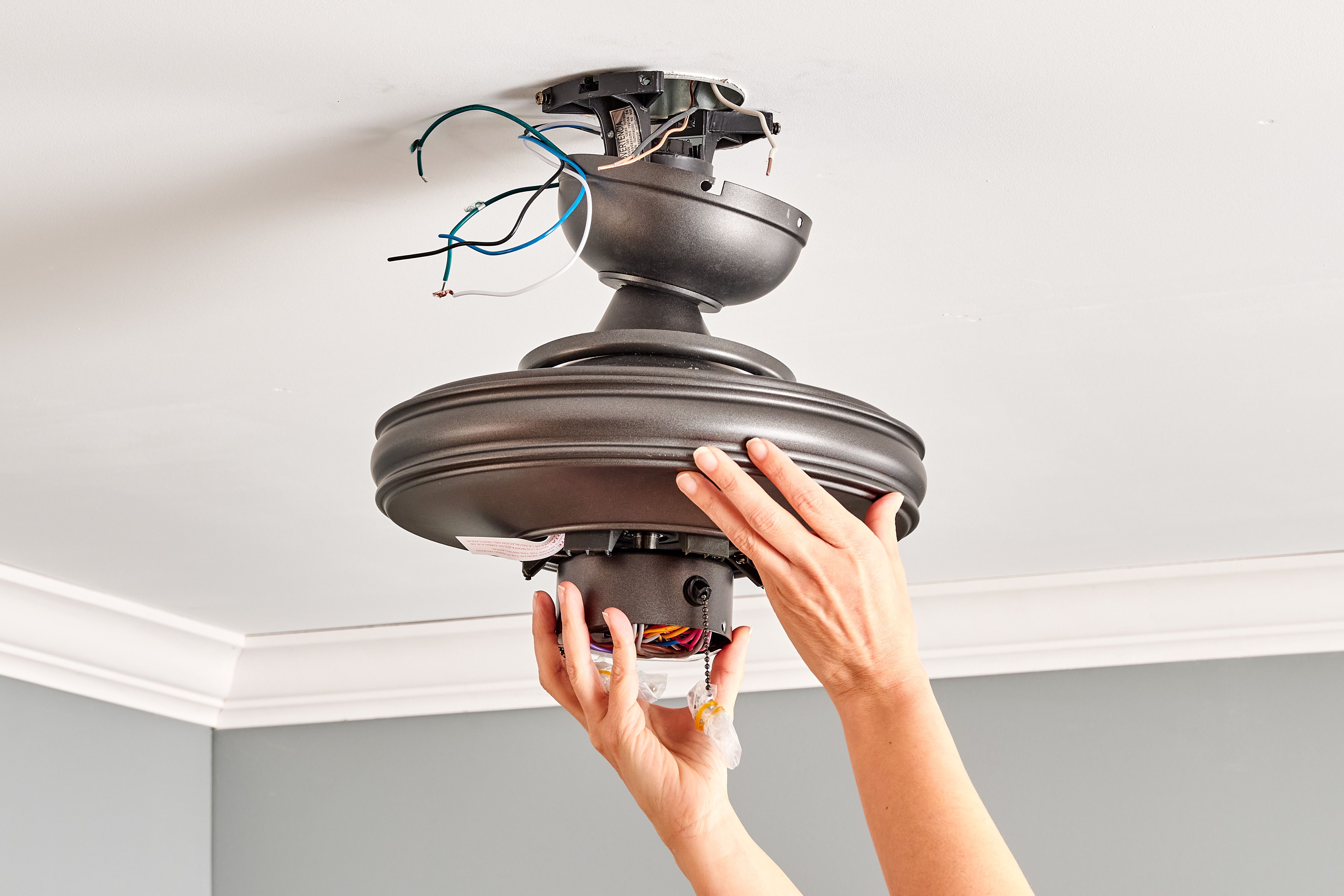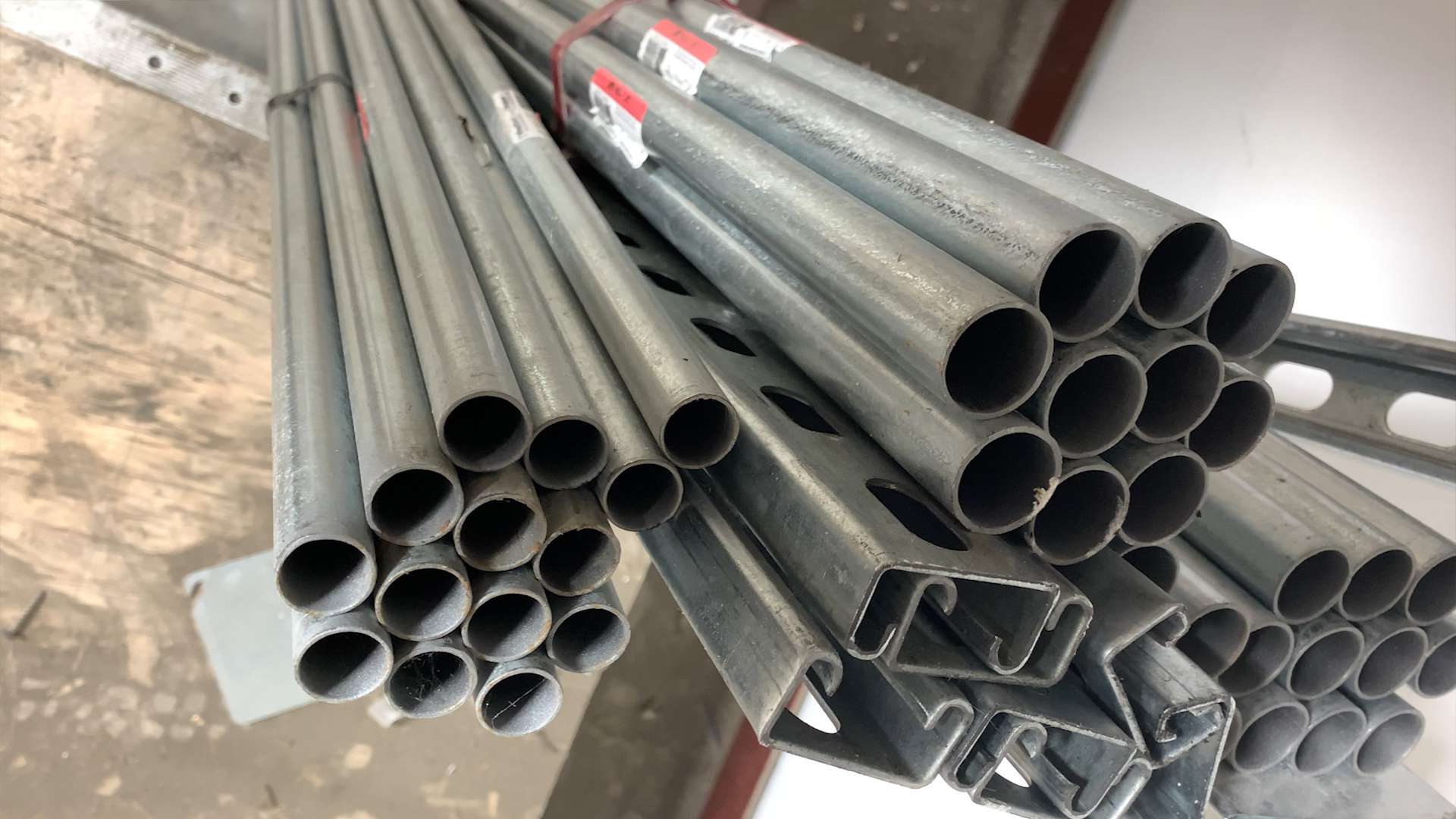

Articles
How Much Weight Can A Ceiling Fan Hold
Modified: May 6, 2024
Discover how much weight a ceiling fan can hold in this informative article. Learn about the key factors to consider when choosing a ceiling fan that can support your needs and preferences.
(Many of the links in this article redirect to a specific reviewed product. Your purchase of these products through affiliate links helps to generate commission for Storables.com, at no extra cost. Learn more)
Introduction
When it comes to purchasing and installing a ceiling fan, one important factor to consider is its weight capacity. Understanding how much weight a ceiling fan can safely hold is essential for both the functionality and safety of your space. Whether you’re replacing an old fan or installing a new one, knowing the weight capacity will help you choose a suitable model and ensure a proper installation. In this article, we will delve into the details of ceiling fan weight capacity, factors that influence it, and how to determine the weight capacity of your fan.
Ceiling fan weight capacity refers to the maximum weight that a fan can support while operating safely. It includes not only the weight of the fan itself but also any additional attachments, such as light fixtures or downrods. Exceeding the weight capacity can put stress on the fan’s motor and supporting structure, leading to wobbling, instability, or even a complete failure of the fan.
Factors such as the materials used in construction, design, and engineering of the fan, as well as the mounting system, determine its weight capacity. Higher-quality fans are typically designed to support more weight, while cheaper or lower-quality models may have lower weight capacities.
When determining the weight capacity of your ceiling fan, it’s important to consider not only the fan’s total weight but also the weight of any additional components you plan to install. For example, if you intend to attach a heavy chandelier or a long downrod to the fan, you need to account for that additional weight to ensure it falls within the fan’s weight capacity limit.
Proper installation is crucial to ensure that your ceiling fan can support its maximum weight capacity. It’s recommended to have your fan installed by a professional who can securely mount it to a ceiling joist or support bracket. The installation process may vary depending on the type of ceiling you have, such as a drywall ceiling or a concrete ceiling.
In the following sections, we will explore the various factors that influence ceiling fan weight capacity and provide tips on determining the weight capacity of your fan.
Key Takeaways:
- Properly understanding and considering the weight capacity of your ceiling fan is crucial for a safe and functional installation, ensuring efficient airflow and enhancing the comfort of your space.
- Prioritize safety by choosing a ceiling fan with a weight capacity that comfortably exceeds the total weight you plan to install, and always follow manufacturer guidelines for a successful and secure installation.
Read more: How Much Weight Can Ceiling Joist Hold
Understanding Ceiling Fan Weight Capacity
Ceiling fan weight capacity is an important aspect to consider when selecting and installing a fan in your space. Understanding how weight capacity is determined and its significance will help you make an informed decision and ensure the safety of your installation.
The weight capacity of a ceiling fan is primarily determined by its design, construction, and the materials used. Higher-quality fans usually have a higher weight capacity as they are built with stronger and more durable components.
The weight capacity of a fan is typically specified by the manufacturer and can be found in the product’s specifications or installation manual. It is important to note that exceeding the weight capacity can lead to serious issues, such as fan wobbling, motor strain, and potential detachment from the ceiling.
It’s essential to consider both the weight of the fan itself and any additional components that will be attached to it. For example, if you plan to install a fan with a light fixture, you need to account for the weight of the fan, light kit, and bulbs. Similarly, if you intend to use a longer downrod to accommodate a higher ceiling, you must factor in the weight of the downrod and the necessary hardware.
It’s important to note that the weight capacity indicated by the manufacturer is calculated based on typical usage conditions. Factors such as the speed at which the fan operates, airflow resistance, and environmental conditions can all affect the fan’s weight capacity. Therefore, it is advisable to stay within the manufacturer’s specified weight capacity rather than pushing the limits.
Moreover, it’s crucial to consider the location where you plan to install the ceiling fan. If you’re planning to install the fan in an outdoor area, such as a covered patio or porch, you may need a fan that is specifically designed for outdoor use. Outdoor fans are built to withstand elements like rain and humidity, and they often have different weight capacity requirements compared to indoor fans.
By understanding the weight capacity specifications of ceiling fans and considering the additional components you plan to install, you can ensure that your fan is safely and properly supported.
In the next section, we will explore the various factors that influence the weight capacity of a ceiling fan.
Factors That Influence Ceiling Fan Weight Capacity
Several factors influence the weight capacity of a ceiling fan. Understanding these factors will help you make an informed decision and ensure that your fan can safely support the desired weight.
1. Materials and Construction: The quality and type of materials used in the construction of a ceiling fan play a significant role in determining its weight capacity. High-quality fans are often made with durable materials such as heavy-duty metals, reinforced plastics, and sturdy motor housings, which contribute to their ability to support heavier loads.
2. Motor Power: The power of the fan’s motor impacts its weight capacity. A more powerful motor can handle a greater load and maintain stability even at higher speeds. Motors with higher wattage ratings are generally capable of supporting heavier fan assemblies.
3. Mounting System: The method and quality of the fan’s mounting system also influence its weight capacity. Ceiling fans are typically mounted using one of the following methods: standard mounting, flush mounting, or extended downrod mounting. Each method has different weight capacity specifications, so it’s important to choose the appropriate mounting system for your specific needs.
4. Blade Design: The design and construction of the fan blades can affect the weight capacity. Blades made from lightweight materials or with a thinner profile may have lower weight capacity compared to blades made with thicker and sturdier materials. Additionally, wider blades distribute weight more evenly, which can contribute to a higher weight capacity.
5. Additional Attachments: Any additional attachments, such as light fixtures, downrods, or remote control receivers, can add to the overall weight that the fan must support. It’s important to factor in the weight of these attachments when considering the weight capacity of the fan.
It is vital to note that each ceiling fan model has its unique weight capacity, which is specified by the manufacturer. It’s crucial to follow the manufacturer’s guidelines and not exceed the specified weight capacity to prevent any safety hazards or damage to the fan.
While it can be tempting to choose a fan based solely on its aesthetics, it is essential to prioritize safety and functionality by selecting a fan that can adequately support the intended weight. By considering the materials, motor power, mounting system, blade design, and any additional attachments, you can ensure that your ceiling fan has the necessary weight capacity for a safe and reliable installation.
In the next section, we will discuss how to determine the weight capacity of your ceiling fan.
Determining the Weight Capacity of Your Ceiling Fan
When it comes to determining the weight capacity of your ceiling fan, there are a few important steps you can follow to ensure accuracy and safety during installation. By taking these steps, you can make an informed decision and choose a fan that can safely support the desired weight.
1. Check the Manufacturer’s Specifications: The first step is to review the product specifications provided by the manufacturer. This information can usually be found in the fan’s user manual or on the manufacturer’s website. Look for the maximum weight capacity indicated by the manufacturer to ensure that your chosen fan can support your specific requirements.
2. Consider the Fan Assembly: Take into account the weight of the fan assembly itself, including the motor housing, blades, and any included accessories. This will give you a baseline understanding of the weight that the fan will add to the ceiling. Keep in mind that the weight capacity should include not only the fan assembly but also any additional attachments, such as light fixtures or downrods.
3. Weigh Additional Components: If you plan to attach any additional components to the fan, such as a light kit or an extended downrod, make sure to weigh these components as well. Add the weight of these attachments to the weight of the fan assembly to determine the total load that the ceiling fan will need to support.
4. Consider Environmental Factors: Take into account any unique environmental factors that may affect the weight capacity of the ceiling fan. For example, if you plan to install the fan in an outdoor area exposed to high winds, you may want to choose a fan with a higher weight capacity to ensure stability and durability under those conditions.
It’s important to note that exceeding the weight capacity specified by the manufacturer can result in safety issues, such as instability, accelerated wear and tear, or complete failure of the fan. Always err on the side of caution and choose a ceiling fan with a weight capacity that comfortably exceeds the weight you need it to support.
In addition to determining the weight capacity of the fan, it’s crucial to ensure proper installation to maximize its weight-bearing capabilities. We will discuss this further in the next section.
By carefully considering the manufacturer’s specifications, the weight of the fan assembly and any additional components, and any relevant environmental factors, you can accurately determine the weight capacity your ceiling fan needs to have, ensuring a safe and secure installation.
When installing a ceiling fan, make sure to check the weight limit specified by the manufacturer. Most standard ceiling fans can hold between 15-50 pounds, but it’s important to confirm the specific weight capacity of your fan before installation.
Ensuring Proper Installation for Maximum Weight Capacity
Proper installation of your ceiling fan is crucial to ensure maximum weight capacity and the safety of your space. By following the recommended installation guidelines, you can optimize the fan’s weight-bearing capabilities and prevent any potential issues down the line.
1. Hire a Professional: For optimal results, it is highly recommended to hire a professional electrician or a qualified installer to handle the installation process. They have the expertise and experience to securely mount the fan to the ceiling joist or support bracket, ensuring proper weight distribution and stability.
2. Choose the Right Mounting System: Select the appropriate mounting system based on your ceiling type and the weight of your fan assembly. The three common types of mounts are standard mounting, flush mounting, and extended downrod mounting. Each mount has specific weight capacity guidelines, so it’s important to choose the one that suits your specific needs.
3. Securely Attach the Mounting Bracket: The mounting bracket is the component that attaches the fan to the ceiling. Ensure that it is securely fastened to the ceiling structure, such as a ceiling joist or a support bracket specifically designed for ceiling fans. Using sturdy screws or bolts will provide the necessary support for the weight of the fan.
4. Follow Installation Instructions: Carefully read and follow the manufacturer’s installation instructions. These instructions provide step-by-step guidance on how to properly assemble and install the fan. It’s important to pay attention to details such as blade attachment, wiring connections, and securing any additional components, such as light kits or downrods.
5. Perform Regular Maintenance: Regular maintenance of your ceiling fan will ensure its longevity and continued ability to bear weight. Inspect the fan periodically for any loose screws or components and tighten them as needed. Clean the fan blades and motor housing regularly to prevent the accumulation of dust and debris, which can affect the fan’s performance.
Proper installation and regular maintenance are essential for maintaining the weight capacity of your ceiling fan. By hiring a professional, choosing the appropriate mounting system, securely attaching the mounting bracket, following the installation instructions, and performing routine maintenance tasks, you can ensure that your fan operates safely and efficiently for years to come.
In the next section, we will address some common questions related to ceiling fan weight capacity.
Read more: How Much Weight Can Ceiling Hooks Hold
Common Questions About Ceiling Fan Weight Capacity
1. Can I exceed the weight capacity of my ceiling fan?
No, it is not recommended to exceed the weight capacity specified by the manufacturer. Exceeding the weight capacity can put stress on the fan’s motor and supporting structure, leading to instability, wobbling, or even complete failure of the fan. Always choose a fan with a weight capacity that comfortably exceeds the total weight you plan to install.
2. How is the weight capacity of a ceiling fan determined?
The weight capacity of a ceiling fan is determined by factors such as the materials used in construction, design, motor power, and the mounting system. Higher-quality fans are generally designed to support heavier weights and are built with stronger materials.
3. What happens if I exceed the weight capacity of my ceiling fan?
Exceeding the weight capacity of a ceiling fan can lead to various safety issues. It can cause the fan to wobble or become unstable, putting strain on the motor and potentially causing damage or failure. It is important to install a fan that can safely support the intended weight to ensure both the functionality and safety of the space.
4. Should I consider the weight of additional components?
Yes, it is crucial to consider the weight of any additional components you plan to attach to the fan, such as light fixtures or downrods. These additional components contribute to the overall weight that the fan needs to support. Make sure to include their weight when determining if the fan’s weight capacity can accommodate the added load.
5. Can I modify a ceiling fan to increase its weight capacity?
No, it is not recommended to modify a ceiling fan to increase its weight capacity. The weight capacity of a fan is determined by the manufacturer based on engineering specifications and design considerations. Modifying the fan can compromise its stability and safety.
6. Are there different weight capacity requirements for indoor and outdoor ceiling fans?
Yes, outdoor ceiling fans typically have different weight capacity requirements compared to indoor fans. Outdoor fans are designed to withstand harsh weather conditions and are often built with more durable materials. They have higher weight capacities to ensure stability and safety in outdoor environments.
7. Can I rely on the weight capacity label on the packaging?
While the weight capacity label on the packaging provides a general guideline, it is important to refer to the manufacturer’s specifications and installation guides for accurate weight capacity information. The manufacturer’s documentation will provide the most reliable and precise information regarding the weight capacity of the fan.
Remember, it’s crucial to prioritize safety by choosing a ceiling fan with a weight capacity that comfortably exceeds the weight you plan to install. By following the manufacturer’s guidelines and considering the additional components you plan to attach, you can ensure the safe and reliable operation of your ceiling fan.
Now, in the final section, let’s wrap up the article.
Conclusion
Choosing and installing a ceiling fan with the appropriate weight capacity is essential for the functionality and safety of your space. By understanding the factors that influence weight capacity, determining the weight capacity of your fan, and ensuring proper installation, you can enjoy a reliable and secure fan installation that meets your needs.
Remember, the weight capacity of a ceiling fan is determined by factors such as the materials used, motor power, blade design, and the mounting system. Higher-quality fans are typically designed to support more weight and are made with durable components.
Determining the weight capacity of your ceiling fan involves checking the manufacturer’s specifications, considering the weight of the fan assembly and any additional components, and accounting for environmental factors that may affect the weight capacity requirements.
Proper installation is crucial to maximize the weight capacity of your ceiling fan. Hiring a professional to install your fan, choosing the right mounting system, securely attaching the mounting bracket, and following the manufacturer’s installation instructions are all essential steps.
It is important to never exceed the weight capacity specified by the manufacturer. Doing so can lead to instability, strain on the motor, and potential damage or failure of the fan. Always choose a fan with a weight capacity that comfortably exceeds the total weight you plan to install.
By understanding and considering the weight capacity of your ceiling fan, you can ensure a safe and functional installation that provides efficient airflow and enhances the comfort of your space.
We hope that this article has provided you with valuable insights into ceiling fan weight capacity. Remember to prioritize safety, follow manufacturer guidelines, and consult professionals when needed to ensure a successful and secure ceiling fan installation.
Now, you are ready to make an informed decision and enjoy the benefits of a well-matched and properly installed ceiling fan for your space.
Now that you've got a solid grasp on the weight capacity of ceiling fans, why not take the next step? Installing a ceiling fan where there was once just a light fixture can transform your room's ambiance and airflow. If you're ready to tackle this upgrade yourself, our guide on ceiling fan installation offers clear, step-by-step instructions to make the process smooth and hassle-free. Don't miss out on enhancing your living space with this practical improvement.
Frequently Asked Questions about How Much Weight Can A Ceiling Fan Hold
Was this page helpful?
At Storables.com, we guarantee accurate and reliable information. Our content, validated by Expert Board Contributors, is crafted following stringent Editorial Policies. We're committed to providing you with well-researched, expert-backed insights for all your informational needs.















0 thoughts on “How Much Weight Can A Ceiling Fan Hold”